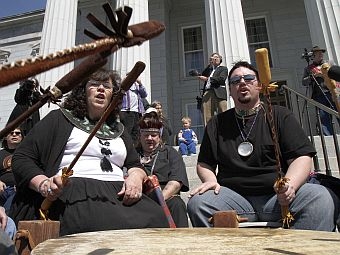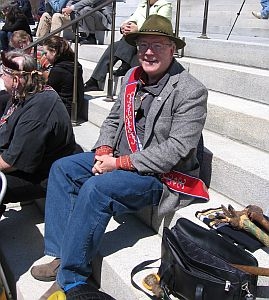Visit the Series Homepage
Vermont Reads 2011: "To Kill A Mockingbird"
 (Wertlieb) Good morning, I’m Mitch Wertlieb. All this week VPR is examining race as part of our 2011 collaboration with the Vermont Humanities Council’s Vermont Reads statewide reading program.
(Wertlieb) Good morning, I’m Mitch Wertlieb. All this week VPR is examining race as part of our 2011 collaboration with the Vermont Humanities Council’s Vermont Reads statewide reading program.
This year the focus is on Harper Lee’s To Kill a Mockingbird. The book examines racial prejudices in the racially-divided south. In this excerpt from the book, the narrator, a young girl named Scout complains to her brother Jem, about the hypocrisy in her teacher’s views on Hitler:
(Excerpt) "She went on today about how bad it was him (Hitler) treatin’ the Jews like that. Jem, it’s not right to persecute anybody is it? I mean have mean thoughts about anybody, even is it."
"Gracious no, Scout. What’s eatin’ you?"
"Well, coming out of the courthouse that night Miss Gas was – she was goin’ down the steps, in front of us, you musta not seen her – she was talking with Miss Stephanie Crawford. I heard her say it’s time somebody taught ‘em a lesson, they were getting’ way above themselves, ‘an the next thing they think they can do is marry us. Jem, how can you hate Hitler so bad an’ then turn around and be ugly about folks right at home."
(Wertlieb) Vermont has long been known as one of the whitest states in the Union. But we’ve always been diverse ethnically and culturally. Immigrants of many nationalities, including Irish, Italian and French-Canadian, were among our earliest settlers. And their presence complicated attitudes about race. St. Michael’s College professor Vince Bolduc says the state had a history with the eugenics movement, that sought to use science to promote racial purity:
(Bolduc) It wasn’t long ago that we had all sort of groups trying to define race by facial structure, by head size, brain size. Most famously of course in the United States in the 1920s we still had people testifying, we had serious scientists including in Vermont working on racial classifications systems and defining what we consider today to be ethnicities as races.
(Wertlieb) You mention eugenics in Vermont, not a happy chapter in the state’s history.
(Bolduc) Well, not a happy chapter in United States history. But it was very well documented in Vermont, and because we’re small enough, and because the organization was small enough, and because the organization was small enough, we were probably able to document it better than other states were. But we have a book done in, it started in the 1920s and 30s by Elin Anderson a sociologist from Harvard who wrote a book called "We Americans, A Study of Cleavage in a Yankee City." And then chronicling that was the work of UVM Zoologist (Henry F.) Perkins called "Breeding Better Vermonters." That was a master’s thesis out of the University of Vermont history department, that was just released a little while ago by University Press of New England. It’s quite a good book, but it’s also very frightening in what we went through in Vermont, in the 1920s and 30s trying to identify races in Vermont and trying to essentially breed better Vermonters.
(Wertlieb) What do you think needs to be done primarily to change those racial attitudes that may still be anchored in the past of a racist tradition?
(Bolduc) Well I think we’re doing a pretty good job of it. It’s slow. One of the ways in which we can look at how successful we’ve been at ignoring racial differences at having these difference just kind of disappear is just what we’d call interracial marriages or interracial friendships. And there’s still, while they’ve increased greatly, there are still quite rare. The census of course has that as a category and for the first time this year they have a category for mixed races and a large number of people chose that for their children and for themselves, that hadn’t chosen it before. And that’s a very good sign.
(Wertlieb) That leads me to ask about interactions with your students you often talk with them about "The Myth of Race." Do they think about race in a very different way than their parents or grandparents do?
(Bolduc) Oh, yes. They do feel as though we should be beyond this. And they hope we’re beyond this. They’re uncomfortable talking about it generally. We were more comfortable talking about it 20, 30, 40 years ago.
(Wertlieb) Now that surprises me.
(Bolduc) Yeah, they are particularly uncomfortable talking about it in a classroom in which there are people of color. And inevitably when I start talking about the subject, or someone says something about it, they turn around and look at the person of color and say how is she reacting, how is he reacting? Now that we’re talking about this issue of race and so they’re not quite as comfortable talking about it as they should be. We used to talk about it more because it was an issue. Now they’d like to think it’s not an issue. And so they don’t talk about it.
(Wertlieb) Vince Bolduc is a professor of sociology at St. Michael’s College. Thanks so much for coming in to speak with us.
(Bolduc) It was a pleasure.
(Wertlieb) For the original Vermonters, the Abenaki, eugenics and racial prejudice led to a life lived in the shadows, where their ancestry was hidden, instead of celebrated.
As VPR’s John Dillon reports, the Legislature has taken steps to put that history behind us:
(singing and drumming)
(Dillon) Roger Longtoe, chief of the Elnu band of Abenaki, sang the high, clear notes of a greeting song in the governor’s ceremonial office.
The occasion was the signing of bills that grant official state status to two Abenaki bands. The room was crowded with lawmakers and Native Americans, who were there to mark the beginning of Abenaki recognition, and the end of a dark chapter in Vermont history.
(Illuzzi) "Our predecessors passed a law, which as a matter of public policy, deemed Native Americans as undesirable."
(Dillon) Essex Orleans Senator Vince Illuzzi has worked on Abenaki issues since the early 1990s.
That’s when the late Caledonia senator Julius Canns, who was part Cherokee, pushed for a resolution recognizing Vermont’s Native American communities.
Canns had cancer, and didn’t live long enough to see the bill pass. Illuzzi sees the legislation as both fulfilling a promise to his late colleague and undoing the legacy left by the eugenics movement. In the 1930s, the state-sanctioned list of "undesirables" who could be sterilized included Native Americans.
(Illuzzi) "We actually took testimony in the early 90s from individuals who were told by their grandparents: ‘Never admit you are Abenaki, never admit you are Indian, because if state officials find out about it, you may end up getting sterilized.’ "
(Dillon) Before Europeans settlement, the Western Abenaki once lived across Vermont, and northern New England. At least 1,700 Vermonters trace their ancestry back to those native people.
State recognition means two Abenaki tribes now qualify for federal education grants and can sell their crafts as native-made. Chief Don Stevens represents the Nulhegan band based in the Northeast Kingdom.
(Stevens) "We have here affected the next seven generations of our children. I mean they can be proud, hold their head up high. They can be eligible for scholarships in the future. We have now a working relationship, an official working relationship with the state of Vermont."
(Dillon) Fred Wiseman is an author, archaeologist and professor at Johnson State College. As Abenakis gathered in the spring sunshine on the Statehouse steps, Wiseman dug into some cloth bags to display artifacts that link their present to the past.
(Wiseman) "This is an original, late 17th early 18th century medal that came from the Abenaki territory."
 (Dillon) Wiseman has put together a study guide for schools to use to teach Vermont children about Abenaki culture.
(Dillon) Wiseman has put together a study guide for schools to use to teach Vermont children about Abenaki culture.
(Wiseman) "Vermont was certainly not a friendly place to be native, because, well, you know, the French and Indian War. So the Abenaki community were both Indian. Bad. French. Bad, and they were Catholic. Bad. So this heritage had to contract in."
(Dillon) Wiseman has served as a scholar for the Vermont Commission on Native American. He’s helped the panel review requests for recognition. The process has been controversial.
Some have charged that people with little or no native blood are being recognized as Abenaki. A recent meeting of the Vermont Commission on native American Affairs degenerated into a shouting match between rival bands.
But Wiseman says genealogical proof isn’t the whole story.
(Wiseman) "For example, my grandmother was of Abenaki descent, but because of eugenics and things we didn’t keep any of that in my family. So the genealogy is only a small part of it. It’s keeping the culture alive. It’s keeping the crafts, it’s keeping the beliefs; it’s keeping the technology. So it’s a whole system. To be a culture, yes, you do have to have ancestry. But for me as an archaeologist and anthropologist, of course, the most important thing is the culture itself."
(Dillon) Wiseman and other advocates say state recognition will not lead to land claims or casinos built on native land. What it does mean, they say is that the Abenaki can now take their legitimate place in the unfolding story of Vermont.
For VPR News, I’m John Dillon.
(Wertlieb) We’ll hear more about racial identity in families, tomorrow morning as our series Vermont Reads, To Kill a Mockingbird continues.
For VPR News, I’m Mitch Wertlieb.